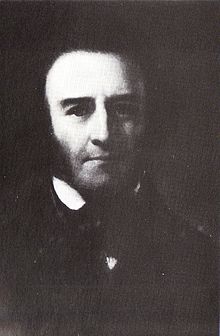James Meadows Rendel (engineer)
| James Meadows Rendel | |
|---|---|

James Meadows Rendel painted by Sir William Boxall
|
|
| Born | December 1799 Okehampton, Devon |
| Died | 21 November 1856 Kensington Palace Gardens, London |
| Nationality | English |
| Engineering career | |
| Discipline | civil engineer |
| Institutions | Institution of Civil Engineers (president) Fellow of the Royal Society |
James Meadows Rendel FRS (December 1799 – 21 November 1856) was a British civil engineer.
Rendel was the son of the surveyor James Rendel or Rendle and his wife Jane, daughter of the architect John Meadows (died 1791); he was born near Okehampton, Devon, in 1799. He was initiated into the operations of a millwright under an uncle at Teignmouth, while from his father he learnt some civil engineering. At an early age he went to London as a surveyor under Thomas Telford, by whom he was employed on the surveys for the proposed suspension bridge across the Mersey at Runcorn. About 1822 he settled at Plymouth, and commenced the construction of roads in the north of Devon. One of his smaller projects, still surviving, was an 1826 bridge over Bowcombe Creek on the Kingsbridge Estuary.
In August 1824 he was employed by the Earl of Morley in making a bridge across the Catwater, an estuary of the Plym within the harbour of Plymouth at Laira. To guard against the undermining effects of the current, he formed an artificial bottom. The bridge, which cost £27,126, was opened on 14 July 1827. With the exception of John Rennie's 1819 Southwark Bridge over the Thames, it was the largest iron structure then existing, and in 1836 Rendel received a Telford Medal from the Institution of Civil Engineers for a paper describing its construction.
He soon entered into partnership at Plymouth with Nathaniel Beardmore, and his practice rapidly grew. In 1826 he erected Bowcombe Bridge, near Kingsbridge, Devon, when hydraulic power was first applied to the machinery for making swing bridges. In 1831 he introduced a new system of crossing rivers by means of chain ferries worked by steam, and in 1832 he constructed a floating bridge on this principle, crossing the Dart at Dartmouth. Between 1832 and 1834 similar floating bridges were erected at Torpoint and Saltash across the Tamar, which greatly facilitated the intercourse between Devon and Cornwall. For these achievements a second Telford medal was awarded to Rendel in 1838. The Torpoint Ferry still operates, albeit much updated. A similar floating bridge was implemented as the Woolston ferry between Woolston, Hampshire and Southampton in 1836.
...
Wikipedia
